SUNDAY
JULY 14 - 2019
Brook
Meadow
This morning
Jean and I walked through Brook Meadow and down to
Slipper Millpond. We noticed the first Hemp Agrimony
in flower on the meadow. Always a late flowering
plant. I managed to get a shot of a Gatekeeper
butterfly hiding away in the long grasses. They will
soon be very numerous on the meadow.

We walked by Peter
Pond where David Gattrell was strimming the east bank.
That man deserves a medal!

The Great Black-backed
Gull family was back on Slipper Millpond. I could see
one of the youngsters on the centre raft while one
parent was on the water nearby. They will all soon be
leaving the pond.
We came back along the
Lillywhite's path where Great Mullein was in flower.
What a dramatic plant!
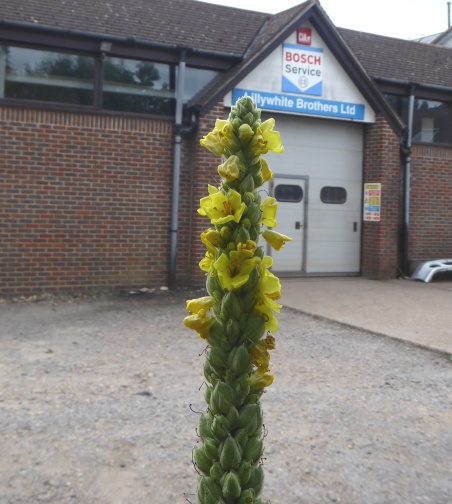
SATURDAY
JULY 13 - 2019
Westbourne
After visiting
the monthly country market in Westbourne church hall,
Jean and I had a short walk along the canalised
millstream to look for Water Voles, which have been
seen there in the past. However, the stream is very
overgrown at present and there was no sign of
anything. We met Dave Lee who regularly walks this
path with his dog and he confirmed he'd not seen any
this year. Dave was pleased to hear that HBC has
turned down the planning application for the houses
behind Westbourne Avenue, but thinks the developers
will appeal.
I spotted a nice flowering of Musk Mallow in
the hedge opposite the stream - my first sighting of
this delicate flower this year.

We walked back via
Whitechimney Row where you have to lean against the
houses to let traffic go by! I recall buying my desk
from one of these houses when we first moved to
Emsworth over 50 years ago. I still have the desk and
use it everyday!
Back to wildlife we were delighted to see lots of
yellow daisies along the roadsides, including
Common Cat's-ear but mostly Smooth
Hawk's-beard which I have only just managed to
identify with any degree of certainty! Here is a nice
patch outside a house in Whitechimney Row where the
owner popped his head out of an upstairs window when
he saw me taking the photo asking what were the
flowers. I was pleased to tell him Smooth
Hawk's-beard!

I also saw a lovely
tuft of Smooth Hawk's-beard growing out of a crack in
the pavement along the main road in Westbourne. Now
that plant has to be admired for its dogged
determination to survive!

Hedgehogs
My trail
camera picked up two Hedgehogs as usual visiting the
garden last night. Here is a nice video clip of one of
them clearly enjoying a good drink from the tray of
water I always leave out for them. Go to . . .
https://youtu.be/jeTkVHL1VDY
Herring
Gull chicks
Marion
Emberson reports there are 3 Herring Gull chicks
(still downy) on the roof of Emsworth House care home,
seen from a top floor flat in Furlonge House this
Thursday. A very good vantage point. Thank you.
FRIDAY
JULY 12 - 2019
Brook
Meadow
A lovely
morning for a stroll through the meadow which was
looking particularly good with head high grasses
swaying gently in the light breeze. Starting at the
Seagull Lane patch I discovered Teasel starting to
flower. The Apple tree in the far corner of the patch
has a good crop of fruit.
Black Horehound is in flower by the path
through the patch just opposite the Red Oak tree, it
has tight whorls of pinkish-purple flowers and nettle
like leaves which give off a musty aroma when crushed.
Black Horehound has been well established on the
Seagull Lane patch for many years, but this was my
first record since 2013. It is an ancient introduction
to Britain.

Walking along the
north path by the railway embankment, I stopped to
admire the newly laid edge to the path completed at
the last workday by volunteers.

At the end of the
north path there is a good crop of wild plants around
the arisings dump, including Bristly Ox-tongue, Hedge
Mustard, Prickly Sow-thistle and Spear-leaved
Orache.

Almost everywhere you
look on the meadow you can see the white flowers of
Meadowsweet which is as good as I van recall
it.

I had a look at the
two circular experimental areas on the north meadow
where I found a few plants of Smooth Hawk's-beard in
flower. They have small yellow flowers on smooth
branched stems and have distinctive leaves with
pointed lobes clasping the stem. Common Ragwort is in
flower, but no sign of any Cinnabar caterpillars as
yet.
Down to the Lumley
area which has a glorious galaxy of flowering plants,
this must be the best area on the meadow botanically
speaking - Red Bartsia, Perennial Sow-thistle (50+
flowering plants), Common Knapweed, Perforate St
John's-wort plus the first flowers of Common Fleabane.
However,
Sharp-flowered Rush which has been so dominant
on the Lumley area for the past 10 years has almost
disappeared. I had to search hard to find any flower
spikes of this interesting plant which was first seen
on Brook Meadow in 2009.

There are plenty of
Yellow Rattle seed pods with rattling seeds
inside.

A very nice bonus was
a small patch of Bird's-foot Trefoil on the
Lumley area which I was not expecting. Checking the
records I see it has not before been recorded on the
meadow, so this is a first!

There were plenty of
butterflies on the meadow, including for the first
time this season Gatekeeper and Small Skipper taking
the butterfly count to 18 species so far this year.
Meadow Grasshoppers were everywhere on the
grassland.

Red Soldier
Beetles were on the flower heads of Hogweed in
some numbers.

I was about to sit
down on Frank's seat on the west side of the north
meadow when I noticed it was being 'attacked' by a
couple of Common Wasps which appeared to be
eating the surface of the wood. I assume they were
taking slivers of the wood to turn into paper to build
their nests somewhere.

Here is a short video
clip of one of the Wasps at work . . .
https://youtu.be/CPtDCIEC_jc
Langstone
Mill Pond
Peter
Milinets-Raby visited Langstone Mill Pond this morning
from 9am to 10:38am. High tide and very warm!
The Mute Swan family were again by the access walkway
to the pond, sitting down having a rest after swimming
out in the harbour. The photo I attach is of four of
the five cygnets all calling softly, signalling the
arrival of the cob bird! Sweet!

Cattle Egret
News
Nest 4: I watched a Cattle Egret chick (definitely
older one) try to strangle/suffocate a second smaller
chick by holding its bill hard on the other birds neck
and bill! Gruesome!
Nest 2: Watched an adult fly in, swap around with the
sitting bird, then this new arrival proceeded to
regurgitate and feed a tiny chick that was barely
visible. That's two nests up and running!
Nest 1: An adult collected a Willow twig and flew into
the Nest 1 site (not visible due to foliage) drop off
the twig and then fly off to Thorney Island.
There were two other non sitting Cattle Egret adults
around, both disappeared to the rear of the main
nesting tree. That makes a total of 6 adults and 3
chicks seen this morning!
A pair of Little
Egrets were building up an old nest on the island.
Very late, though probably a second brood. The male
was bringing in a stick every 2/3 minutes and passing
it to the female very quickly. She was very busy on
the nest, weaving in the sticks. Its great having them
this close!

Other birds of note
this morning on the pond were a single female Tufted
Duck, 1+ Reed Warblers dashing about and hawking over
the pond were 3 Swallows and 2 Sand Martins.
On the high tide Sweare Deep channel was a single
Great Crested Grebe.
THURSDAY
JULY 11 - 2019
Kestrel
in garden
Jean and I
were having our evening meal outside on the patio at
about 6.30 when the flock of White Doves that mop up
the fallen seeds under the feeding station suddenly
took off in a flurry of wings. I looked up and spotted
the perpetrator of the commotion perched on the apex
of my neighbour's roof. I could not see it too well
against the light sky, but assumed it was a
Sparrowhawk, and probably a female from its small
size. The bird stayed on the roof just long enough for
me to get a couple of shots of it with my camera
before it flew off. It was not until I looked at the
images on my PC that I realised the bird was in fact a
male Kestrel. This was the first Kestrel I have ever
recorded in my present garden over the past 22 years.
Sparrowhawk is a fairly common garden visitor, but
Kestrel is quite rare.
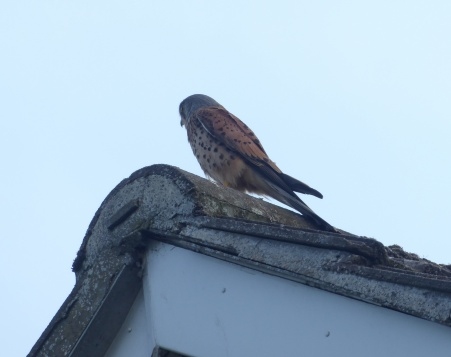
A few minutes later
the White Doves returned and ironically one of them
perched on the roof in exactly the same spot as the
Kestrel a few minutes before! The Kestrel would have
been welcome to a White Dove, though its size would
make it a difficult prey to catch., though I reckon a
female Sparrowhawk could take one.
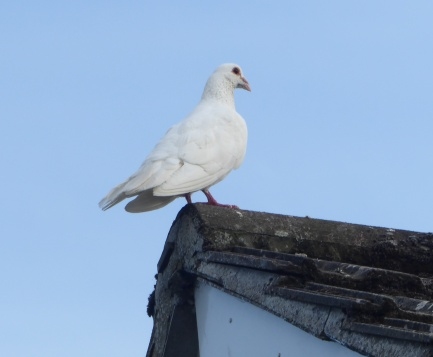
Hedgehogs
The trail
camera picked up visits from both the regular male
Hedgehogs that I am now able to identify individually.
The hog with a bad limp on its back legs that I call
'Limpy' arrived first to clean up the few mealworms I
sprinkle in front of the camera.
See video clip of
Limpy last night . . . https://youtu.be/IIBA2-LoH6U
The hog that moves
well without a limp and regularly pushes Limpy around
when they are both on camera I call 'Bossy'. Bossy
arrived in early morning and was caught on camera
passing close to a cat which took little notice of it.
My trail camera gives a fascinating, if limited,
insight into some of the activities that take place
when we are all asleep.
See video clip of
Bossy with the cat last night . . . https://youtu.be/fCqLob2tbC0
WEDNESDAY
JULY 10 - 2019
Langstone
Mill Pond
Peter
Milinets-Raby visited Langstone Mill Pond this morning
from 9am to 10:44am - tide slowly going out.
As the tide dropped the waders flew in. Off Conigar
Point in the distance were 6 Shelduck and 10
Black-tailed Godwits.
On the shore adjacent to where the Wade Lane path
emerges were 17 Little Egrets feeding in amongst the
sea marsh. Amongst them were 2 Cattle Egrets (see
photo).

Along the tideline
were 56 Redshank (virtually double the numbers from
yesterday) along with 2 Greenshank (One close enough
to get colour ring details - NR//- + YY//- 11 previous
sightings - last seen in November 2018.
Also off shore were 2 Common Tern, 20+ Med Gulls
passing over and the Mute Swan family walked out onto
the mud as the tide dropped (see photo).

On the pond there was
a single female Tufted Duck, a couple of Reed Warblers
and 21+ Little Egrets loitering. The last of the Grey
Herons were exercising their wings in anticipation of
fledging.

Apart from the two
Cattle Egrets on the sea marsh there were 4 other
birds around. Birds could be barely seen sitting on
Nests 2 and 4 (With the scope, I could just make out a
fluffy, but scruffy chick being fed by the adult on
Nest 4, but otherwise the adult was sitting down most
of the time).
Two adults then flew
in and oddly did not visit any of the four known nest
sites. They both landed at the top of the trees above
the Grey Heron nest, had a squabble then disappeared
into the rear of the trees beyond the main nesting
tree. This just confuses matters. Counting successful
breeding attempts is going to be very tricky indeed,
especially when there are obviously nests that are out
of sight!
TUESDAY
JULY 8 - 2019
Bridge
Road Wayside
I had an
interesting meeting this morning at 10.30am in Bridge
Road car park, arranged by Brendan Gibb-Gray, with
three residents of Hayling Island (Lesley, Eric and
Judy) who are aiming to kick start a waysides project
on the island similar to the one we launched here in
Emsworth almost 10 years ago. Yes, it really is that
long ago . . . the inaugural meeting of the Friends of
Emsworth Waysides took place on 3 September 2009 in
the Crown Hotel, Emsworth.
First we stopped to
look at the council mown grass verge at the southern
entrance to the car park which has a variety of
interesting flowers and grasses, which are encouraged
by regular mowing.

In contrast the
wayside to the east of the car park which is only mown
once a year is a veritable jungle of grasses and
flowers - no doubt supporting a great range of
invertebrate wildlife.
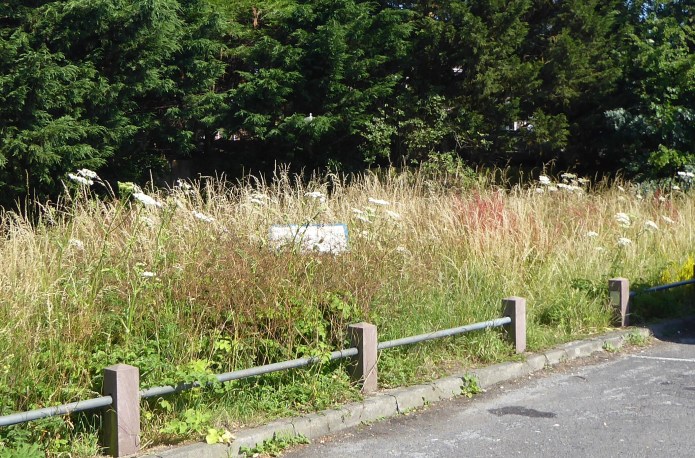
We noted a few
beetles, but the highlight of the morning were several
Gatekeeper butterflies which we saw flying on
the wayside - the first of the year. Here are a couple
of shots I managed to get.
We went on a little
tour of the wayside, during which I pointed out some
of the more interesting plants, including two types of
Bedstraw, Hedge Bedstraw and the aromatic Ladies
Bedstraw. There were also several varieties of grasses
which are the backbone of any wayside.
Personally, I was
pleased to discover a small tuft of Lesser
Swine-cress (Coronopus didymus) growing
from the edge of the verge at the northern entrance.
And later I also noted
the first flowering of Vervain on the edge of
the northern shrubbery.

The Hayling visitors
promised to keep in touch and I, in turn, I agreed to
visit their sites to help out with plant
identification.
At the end we trouped up Victoria Road, stopping at
Julian's nursery to buy a few plants, and on to Brook
Meadow. We managed to find a single Pyramidal Orchid
still in flower, along with several seed heads of
Southern Marsh Orchids. But not enough time to explore
further.
Langstone
Mill Pond
Peter
Milinets-Raby walked down Wade Lane this morning and
visited Langstone Mill Pond for an hour from 9am - the
tide was out.
Along Wade Lane were a singing Chiffchaff and a 11 Med
Gulls over. By the horse paddocks there was a Swallow
flying around.
Off shore there was a large influx of Redshank feeding
along the shore. There were five the other day, now
29! Also with them was a Greenshank and 3 summer
plumaged Dunlin. Also of note was a Common Tern and
the Mute Swan family in the mill outflow. Alas, the
cygnets were down to five and the missing bird was as
expected the one with the damaged right eye!
Shame.
On the pond there was a female Tufted Duck with three
"growing" ducklings (see photo), plus a singing Reed
Warbler, a singing Chiffchaff and a Sparrowhawk
over.

There were 24+ Little
Egrets loitering.
The Cattle Egrets were quiet (a bit windy). Four birds
were noted, these being sitting adults in Nests 2 and
4, plus two adults preening in the Willow trees for a
few minutes before both of them flew off towards
Thorney Island.
SUNDAY
JULY 7 - 2019
Garden
butterflies
After the rain
stopped this morning I spotted a brown butterfly
fluttering low over the lawn in the back garden.
Meadow Brown? No, a closer look when the insect rested
on the ground, revealed a handsome Ringlet. I
managed to get a quick snap before it took off.
Following the Essex Skipper just four days ago, this
was another first for the garden! Two garden rarities
in the space of a week. What next?
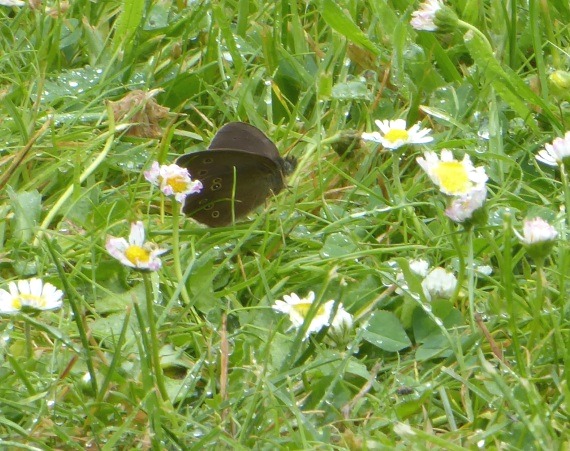
After seeing the Essex
Skipper, I had an e-mail from Bob Marchant to say he
was reading about the Cattle Egrets nesting at
Langstone Mill Pond in my blog when he noticed the
post regarding Essex Skipper. Bob also had an Essex
Skipper in his Locks Heath garden - also a first for
him! He wonders if there has been an influx of
them?
I have not seen a Essex Skipper anywhere else this
year, though Ringlets are certainly having a good year
on Brook Meadow where they are flying in good numbers
along with the slightly paler Meadow Browns.
Brook
Meadow Workday
I went over to
Brook Meadow by 9.30 for the regular work session.
There was a good turn out of 10 volunteers despite
light but steady rain which lasted all morning.

Maurice was leading
and had planned two tasks: 1. cutting back nettles and
other vegetation overhanging the main pathways

2. reinforcing the
north path with boards and gravel. Thus was a hard job
that engaged several volunteers. The sides of the path
were dug away and boards staked along the edges later
to be filled in with gravel.

For the full workday
report and more photos go to . . . https://www.brookmeadow.org.uk/conservation-news/
Wildlife
observations
Some of the
Lesser Burdock plants were inadvertently cut
during work on the Seagull Lane patch. I asked Dan to
hold up one of the cut leaves, large and fresh, but
nowhere near the size of the Butterbur leaves which
are now out below the main seat.

The tiny pink flowers
of Great Willowherb are now out generally
across the meadow.

Also in flower in the
north-east corner of the meadow is the much maligned
Ground-elder. This plant is the bane of
gardeners, but is very welcome on our nature reserve
where it takes its place well among the other wild
plants.

There is a magnificent
flowering Hogweed (at least 8 feet tall) on the
east side of the north meadow.

The two experimental
circular areas on the north meadow are starting to
show the value of regular cutting from the
conservation group. It has taken 4 years for the
Corky-fruited Water-dropwort to show up after
the seeds were originally sown in 2015. There are now
several plants on the northern area in flower. The
flower head is similar to that of Yarrow. As with all
nature, the message is patience! There is as yet no
sign of the other two seeds that were sown at the same
tine in 2015, namely Common Knapweed and Meadow
Barley.

Two plants (not sown)
which are doing well on these experimental areas are
Selfheal
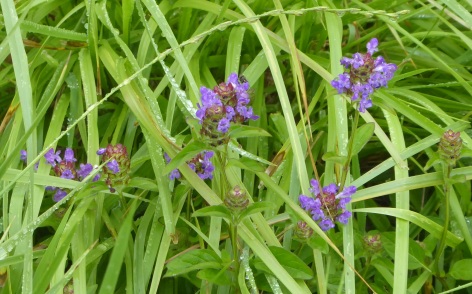
and Creeping
Bent-grass. Here is a photo of the typical closed
up red tinged panicles of this delicate grass.

Cattle
Egrets on Thorney - update
Steve Hooper
reported that he had seen adult Cattle Egrets flying
from the fields on West Thorney towards the woodland
behind the New Life Christian Church estate on the
east side of Thorney Road. He wondered if they might
just be nesting somewhere in that location, but his
efforts to gain access to the area were politely
refused!
However, now Barry Collins has confirmed to me that
Cattle Egrets definitely have not bred on Thorney. He
says . . .
"Margaret
and I first noted Cattle Egrets feeding in amongst the
cattle at Thorney Deeps on 27th May when 4 summer
plumage birds were seen. They peaked at 7 all in
summer plumage on 1st and 2nd June and since then 5
have been seen on a daily basis feeding in amongst the
cattle. Please note all the birds seen have been
adults. Just like you I kept quiet just in case they
might breed at Thorney, but I suspected if they were
going to breed anywhere it would be Langstone Mill
Pond or nearby."
Photo of Cattle
Egret by Peter Milinets-Raby - Warblington 5 Feb
2019

SATURDAY
JULY 6 - 2019
Brook
Meadow
I had another
look at the two circular experimental areas on the
north meadow that are regularly mown by the
conservation group. I found yet more flowering plants
of Corky-fruited Water-dropwort, this time on
the northern area. The seeds of this plant were
originally sown by the group in Sep-2015, so they have
taken 4 years to emerge! The attractive flowers of
Selfheal are also out on the southern area.
At least two
Ringlets were flying on the south area which
obligingly rested for a photo, one with wings closed
showing the distinctive ringlets, and the other with
wings open. In fact this has been a good year for
Ringlets on the meadow. They rarely settle long, but
can be picked up in flight from their dark brown
wings; the numerous Meadow Browns are usually much
paler.
I came across a
Speckled Wood resting unusually with wings
closed on the handrail of the north bridge. We are not
used to seeing Speckled Wood underwings.

Elsewhere on the
meadow, Perforate St John's-wort is in full flower on
the north edge of the Lumley area and Great Willowherb
is just starting to flower. The first Marsh
Woundwort is opening in the usual spot on the
north east corner of the south meadow and what I think
is Field Forget-me-not is out on the south meadow (it
could be Water Forget-me-not?).
Three Song Thrushes
are still singing and a Blackcap. While mooching
around the Lumley area I spotted a large web with an
opening from which emerged a spider. This could be a
Labyrinth Spider (Agelena labyrinthica)
??

FRIDAY
JULY 5 - 2019
Cattle
Egrets breeding at Langstone Mill Pond
As you all
must know if you have been reading this blog, Peter
Milinets-Raby has been monitoring the breeding of Grey
Herons and Little Egrets at Langstone Mill Pond
throughout the summer season. However, Peter has also
been monitoring far more interesting birds breeding in
the same colony, namely Cattle Egrets. Peter withheld
publicising this information due to the danger of
alerting egg collectors to the site. Peter has kindly
kept me fully informed of the progress of the Cattle
Egrets, but asked me not to publish anything about
them until the chicks are confirmed. But now we can
publish the wonderful news!!
Here is Peter's report as follows . . .
"At long last this
morning I saw a tiny chick in Nest 4, the first
confirmed breeding of Cattle Egret in Hampshire. I had
suspected that this was the case for the last few
days, but the restricted views of the nests makes
observation very tricky indeed. Now that the threat of
egg collectors is over, the following short summary of
this historical event can now be told.
As everyone is aware
during the winter the fields around Castle Farm,
Warblington held up to five Cattle Egrets. In previous
years the wintering birds had departed by late
February, but this year the birds lingered into March,
then April. From late March onwards, they were often
in the fields with 20+ Little Egrets. The Little
Egrets were pairing up, displaying and developing
spring plumes and I thought it was only a matter of
time before this behaviour would rub off on the Cattle
Egrets. However, to my disappointment the Cattle
Egrets just suddenly vanished (My last sighting was on
23rd April) and were not seen subsequently. The chance
of breeding had gone, or so I thought! On the 24th
April I noted that there were already 18+ pairs of
Little Egrets established at Langstone Mill Pond.
Then, right out of the
blue on 2nd June, 5 Cattle Egrets suddenly appeared in
the Little Egret colony at Langstone Mill Pond. Where
had they been for the intervening 38 days? By the 8th
June the birds had started to settle down and at least
four nest sites were beginning to be established (The
birds almost certainly using old Little Egret nests).
Also, on this date I had my highest count of 8 birds.
Over subsequent visits usually only 4 to 5 birds would
ever be seen. The non sitting adults never seemed to
hang around, which made confirming nest sites
virtually impossible. Two of the four "certain" nests
sites are not visible, hidden by foliage. Nest 2 is
barely visible (a quarter of a sitting bird can be
seen if you are lucky) and Nest 4 is visible, but with
a very restricted view. During the month of June, I
suspected there to be a further three nest sites, but
as the location of these are unobservable, their
confirmation can only be established when the Cattle
Egrets start to regularly feed their young and the
young start to grow and wander about like the Little
Egret chicks do. So there are possibly seven nests. I
use the term "nests" as opposed to "breeding pairs" as
I suspect that one male may be responsible for two or
more of the nests?
At the moment if you
visit Langstone Mill Pond you will not actually see
much. You may be lucky and catch a glimpse of a non
sitting adult. This morning, there were only three non
sitting adults present, though two of them soon flew
off towards Thorney Island. The third is a bird that
is nearing the end of its "Nuptial" plumage. It has
started to loose interest in Nest site 6 and wanders
off into the back of the Willow Trees and thus out of
sight. If you get a glimpse of this bird, it is still
sporting a two toned bill of orange tip and crimson
base and purplish cere. Plus it has crimson legs.
These bare part colours are fading now, but still
worth a look. The fact that this bird has been in this
"Nuptial" plumage for 16 days now, suggests that it
has probably failed to find a mate. All the earlier
successful adults lost their "Nuptial" plumage after a
week!
Non sitting
adults after the flushed bare parts fade
Photos of birds in
"Nuptial" plumage.
Hopefully, by next
week there should be plenty of activity as the adult
birds bring in food and consequently the numbers of
nests can be confirmed.
The last interesting question is, where do these birds
go? They are not feeding locally. They always fly off
to the east and stay in the air until I loose them way
over north Thorney Island. Is there another nesting
colony in that direction? The report of a pair feeding
a fledged youngster on 23rd June on Thorney Island
might suggest this. This date hints that this colony
became established in the first week of May, which
sort of fits in with the sudden disappearance of the
birds at Warblington! A point worth
pondering.
Postscript
As so often happens, the breeding Cattle Egrets were
also discovered by another local birder who was
visiting the site for the first time for 3 months. He
decided to spread this news on the very same day that
Peter found the first chick. So now the news is well
and truly out! But our praise must go to Peter for his
determined diligence in observing the birds over the
past few months. Brilliant work and well done. If I
was the Queen I would give him a medal!
THURSDAY
JULY 4 - 2019
Hedgehog
in garden
I had just one
Hedgehog on the trail camera in the garden last night.
It was the regular male with a bad limp on its back
left leg which it tends to drag when it walks.
However, on previous nights I have seen another male
without a limp, so maybe we have two male
visitors?
Video clip of male
Hedgehog limping . . . https://youtu.be/NB9JtKG6FhQ
Video clip of male
Hedgehog scratching . . . https://youtu.be/Y90gW7dvkcw
Swifts
May people
have been reporting Swifts flying in the local area.
We had four flying low over our house in Bridge Road
this morning which is the most we have seen this year.
It was so good to see them after many barren years
with hardly anything. Just think 20 years ago we had
up to 20 Swifts screaming around the houses in Bridge
Road. My son, who lives in Cowes on the Isle of Wight,
tells me he regularly sees up to 30 Swifts flying
around the houses in his area. Lucky chap!
Essex
Skipper in garden?!
I was
surprised and delighted to see what looked like a
Small Skipper feeding on the Perennial Verbena flowers
in the garden this afternoon. That would be a garden
first. However, when I saw the jet black tips to the
insect's antennae ('as if dipped in ink') I
immediately thought of the much rarer Essex Skipper. I
have nothing else to go on but for the black antennae
tips, but I am sticking to it as a unique garden
sighting. PS I have done nothing to the photo except
reduce it for the web site.
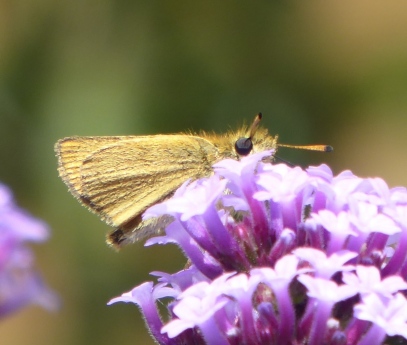
Beautiful
Demoiselle in garden
Talking about
unique garden sightings, Caroline French had a female
Beautiful Demoiselle in her North Emsworth garden
where she says there is no water but for a bird bath.
These damselflies are fairly common on Brook Meadow
though I have not heard of one turning up in a 'dry'
garden before. The male Beautiful Demoiselle has all
dark blue wings. Here is Caroline's photo taken on her
phone. Not bad!

Slipper
Millpond
It was such a
beautiful evening so I popped down to Slipper Millpond
to check on the Great Black-backed Gulls. One
of the adult birds was keeping watch on the southern
raft where the pair nested.
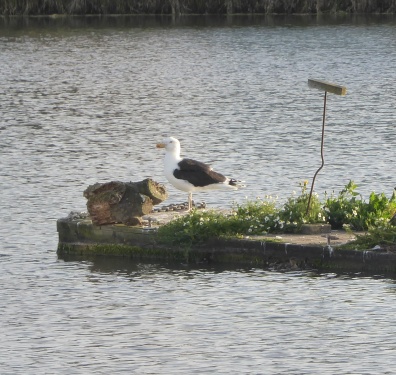
The two youngsters
from this year's brood were snoozing on the larger
centre raft. They presumably flew the 50 yards or so
from the nesting raft which means they have now
fledged, though are probably not confident enough as
yet to venture far from the rafts.
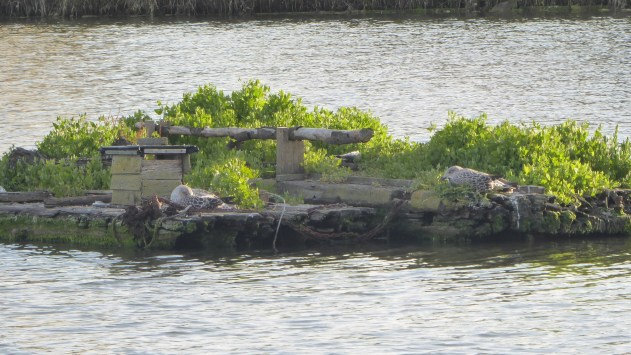
The Mute Swan
family with its truncated brood of 3 cygnets was
on the pond near the Hermitage Bridge. All youngsters
looked fine and healthy.

WEDNESDAY
JULY 3 - 2019
Hedgehogs
The pair of
Hedgehogs was back in the garden last night, caught on
the trail camera taking an active interest in each
other. Much as on previous occasions when two are
present there is a good deal of snuffling, with the
male (with penis) constantly circling around the
female (with extruding genitalia?) who in turn keeps
her rear end well away from his attentions. I did not
see them actually mating, though they were not in the
range of the camera all the time.
Here are two short
clips of the Hedgehogs circling and snuffling
. . . https://youtu.be/RquoZBe5OVA
. . . https://youtu.be/7AVK317a9V4
Langstone
Mill Pond
Peter
Milinets-Raby visited Langstone Mill Pond this morning
(9am to 10:38am - tide pushing in).
The highlights were alas more indication that summer
is nearly over and autumn is on its way, with a small
flock of 8 Black-tailed Godwits feeding along the tide
line and the familiar calls of Greenshank could be
heard. Two birds were feeding along the incoming tide,
one with colour rings (too hazy to see details, apart
from "yellow"). As the tide pushed in they flew off
towards Thorney Island and the Godwits flew off over
Hayling Bridge heading into Langstone Harbour.
Also flying around this morning were 2 noisy Sandwich
Terns and a Common Tern. I also had a probable
Great White Egret this morning. I picked it up
late in the scope as it flew east along the north
Hayling shoreline and headed towards the centre bit of
Thorney Island. I was 95% certain it was one, just too
hazy a view, but what else could it be?
Other birds of note were a pair of Tufted Duck, 2+
Reed Warblers, a Great Spotted Woodpecker and 3 Med
Gulls passing over.
TUESDAY
JULY 2 - 2019
Hedgehogs
My trail
camera picked up a pair of Hedgehogs in the garden
last night, circling around and snuffling in their
usual fashion.
See video clip at . . . https://youtu.be/gFKNF53kUK8
The female (with no
penis!) was back in early morning to pick up any
remains of mealworms.
See video clip at . . . https://youtu.be/GDCgvEGTxAc
House
Martins
Sue Thomas has
seen lots of House Martins nesting in several places
locally, but not sadly anywhere in Emsworth!
10 were flying around one nest on house in Russet
Gardens Chidham and up to 30 over pond in Chidham.
There is a House Martins nest on house in Camellia
Close, Denvilles. Sue also saw lots of House Martins
in Westbourne where Caroline French did a survey
several years ago. Edgell Road, in at least two front
door porches, Churcher Road 3 separate birds going in
and 1 in a nearby house in the eaves of flats. 12
nests on one block of flats. At least two birds
entering separate nests in Mill Road. Photo is from
Churcher Road flats.

Swallows
and Gulls
Peter Bullen
had the pleasure of seeing Swallows on the
telephone wires at the top of Penny Lane, flying
lessons interrupted for feeding.

Yesterday, Peter
watched Black-headed Gulls feasting on tiny fish as
the millpond was gushing out.

MONDAY
JULY 1 - 2019
Brook
Meadow
Regarding the Corky-fruited Water-dropwort that
I discovered yesterday on the north meadow Jennifer
Rye reminded me that the group did sow some seeds of
this plant on the experimental circles on the north
meadow which are regularly cut by the group. Pam
Phillips also recalls this sowing.
Having searched through my wildlife diaries, Jennifer
and Pam are quite right. I had forgotten about the
seed sowing that took place on the two regularly mown
circles in Sep-Oct 2015. The seeds sown were
Corky-fruited Water-dropwort, Meadow Barley and Common
Knapweed - provided by Gareth, an ecologist, from
Aluco Ecology and sourced from the Interbridges Site
which at the time was up for industrial development,
though this has yet to happen. Yellow Rattle seeds
from another source were also sown.
Gareth also gave us advice about grassland management
which I thought it would be useful to have on record
so I have reproduced it below.
The seeds were sown during two work sessions; the
northern area on 17-Sep-15 and the southern area on
15-Oct-15. Both areas were cut and cleared of arisings
before Wally used the brush cutter to scarify 30 small
areas to provide a better habitat for the seeds to get
established. Here are some photos of the work on
17-Sep-2015 . .

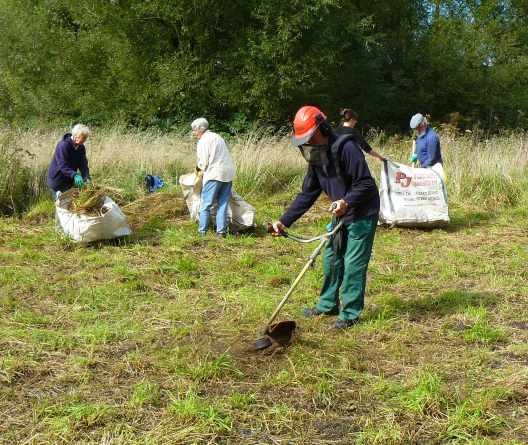
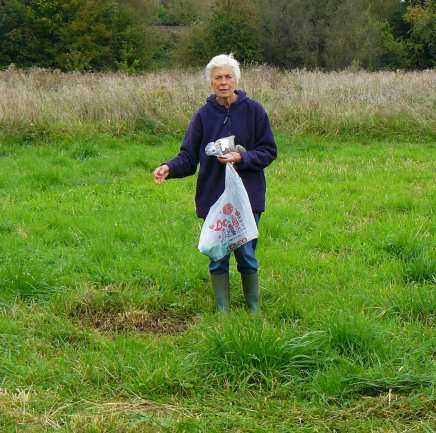
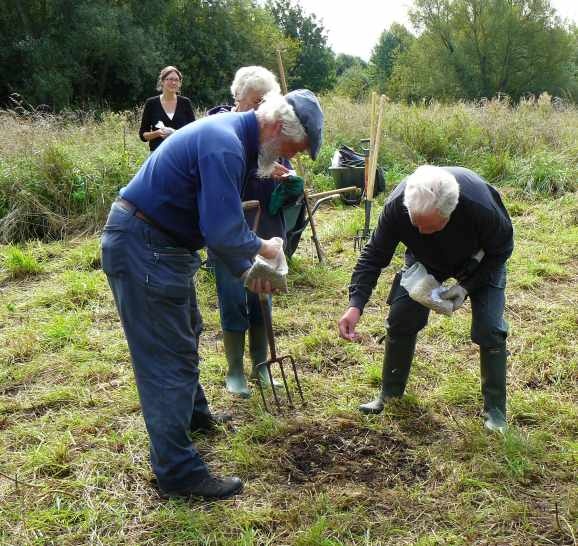
I have regularly
checked these two areas since they were first cut. The
cutting has certainly led to a wider range of plants
than would have been present without the cutting. You
only have to compare them with the areas around the
circles which are largely dominated by tall grasses,
such as, Tall Fescue. The southern of the two circles
is by far the better from a botanical viewpoint. It
has a wider range of more interesting plants including
the best growth of Jointed Rush and Creeping Bent
anywhere on the meadow.

Today's plant survey
for the two circular areas produced a total of 36
species
Amphibious Bistort, Black Medick (south only), Bristly
Ox-tongue, Broad-leaved Dock , Broad-leaved
Willowherb, Cat's-ear (south only), Clustered Dock,
Cocksfoot , Common Fleabane, Common Mouse-ear, Common
Ragwort (2 plants on north),Corky-fruited
Water-dropwort (near southern area), Creeping Bent
(south only), Creeping Buttercup, Creeping Thistle,
Curled Dock, Dandelion, False Oat-grass, Field
Horsetail (south only), Greater Plantain, Hard Rush,
Hogweed, Jointed Rush, (south only), Meadow Buttercup,
Meadow Foxtail, Perennial Ryegrass, Prickly
Sow-thistle, Red Bartsia (south only), Red Clover,
(south only), Ribwort Plantain, Selfheal (south only),
Soft Brome (south only), Spear Thistle, Tall Fescue,
White Clover , Yorkshire Fog.
Personally, I have
never found any of the plants that were originally
sown on these two mown circles - that is until now!
The Corky-fruited Water-dropwort that I found
yesterday was, in fact, a few metres outside the
southern area. The only place I am aware that
Common Knapweed grows on Brook Meadow is the
Lumley area.
As for Meadow
Barley, I am constantly searching for this elusive
grass, but have not seen any on Brook Meadow since
2015. I am surprised that the Yellow Rattle has
not taken. I think we should re-sow this useful grass
parasite on both circles using seeds from the
meadow.
The so-called 'play
area' which is close to the northern circle, deserves
be included in the regular cutting programme along
with the two circles. There is a very good growth of
Barren Brome grass on the play area - not present on
either of the circles. There is also Cut-leaved
Crane's-bill which is not on the circles.
Brook
Meadow grassland
Report from
Gareth of Aluco Ecology: Sep-2015
Annual
cutting is preferable in areas where you wish to
maintain a hay meadow vegetation and reduce the Tall
Fescue, eg areas you may sow with Yellow Rattle this
year.
If you can cut, let dry (ensure cutting is during dry
spell), then collect hay, this cutting can be done
from July/Aug onwards. This is how meadows are
traditionally managed (followed by some winter
grazing). The earlier it is done the less nutrients go
back into the grasslands, which is better for reducing
grass vigour; but some late flowering species may
loose the opportunity to flower and seed.
If you continue with cut and collect as a single
operation, the hay meadow areas should be cut later in
autumn as you do, so that seed has been dropped,
particularly important for the annuals such as Yellow
Rattle.
If you wish to cut your flower rich areas and spread
the green hay onto poorer areas this should be done
straight away, and cut during dry periods to allow hay
to dry. Then collect a few days later.
Langstone
Mill Pond
Peter
Milinets-Raby visited Langstone Mill Pond this morning
from 9am to 10:28am - tide pushing in to high. Little
ones were everywhere.
The Mute Swan pair still had six cygnets and
were looking good, though one cygnet does have a
damaged eye. They were on the pond for a short while
before crossing the path and venturing out into the
harbour. The Tufted Duck was present this
morning with her 3 remaining ducklings.


A new brood of Mallard
(with 5 tiny ducklings) were on show and up to three
noisy pestering recently fledged Black-headed
Gull juveniles were constantly chasing their
parents. Other birds of note were Reed Bunting (male),
7+ Med Gulls passing over, 2+ singing Reed Warblers
heard, 2 Swallow, 42+ loitering Little Egrets (About
75% of them juveniles virtually capable of flight - I
can see at least two adults still sitting on nests.
Are these second broods or just late
starters?).
Off shore were 2
Common Tern and probably the birds of the day were 2
Black Swans that flew west along the channel and flew
up over the Hayling bridge.
For
earlier entries go to . . . June
16-30